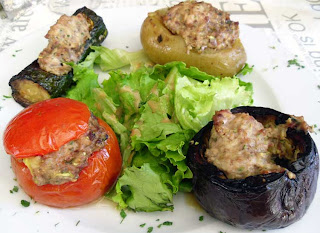One of the problems you encounter with foreign menus is that the locals are on a first-name basis with dishes that you’ve never met. Or, in the south of France, they can tutoyer the meals, referring to them by the familiar tu form when you haven’t yet been introduced to them. Let’s say you’re in France, and you see some menu choices.
Well, you could get aïoli. Excellent selection, madame. It’s often the plat du jour on Friday. So you look it up in your guidebook’s food section. And I can nearly guarantee that you’ll be told, correctly, that aïoli is a mayonnaise strongly flavored with garlic. As it turns out, I’m not a mayo fan normally, but I can lick aïoli right off of a spoon. But that doesn’t mean I could have it as my whole lunch.
And luckily for me, neither could anyone else. The main dish called aïoli (short for grand aïoli) actually comprises a portion of seafood or vegetables (Friday remains a fish day in France, a repealed religious principle that people continue to observe while breaking most of the still-standing ones.)
The point is that this isn’t just a big mess o’ mayo, it’s a plate in which the mayo plays a starring role. They just never mention the food that goes with the mayo, arguably an important oversight. Come to think of it, this reminds me of fondue, which simply means “melted”. But nobody’s dipping pricey shellfish into melted cheese.
Similarly, in Provence, they will serve purée alongside your meat or fish (and sometimes underneath it.) Purée, unadorned with further description, is what we’d call mashed potatoes. And potatoes can be ignored in another popular Provencal dish called “farcis”. The word “farcis” means “stuffed.” And without further elaboration, it means that veggies – peppers, eggplants, zucchinis, potatoes, or tomatoes, for example – are stuffed with a mixture and baked until they are caramelized. But the dish is called “stuffed”, not telling you anything specific about either the stuffing or the stuffee. And once in awhile, you’ll see elaboration for it on the chalkboard: ”Petits farcis” or “little stuffed”. Hmmm, does that mean that the vegetables are small or that they’re only a little stuffed?
So it’s a dish, in a word. And if I remember my poetry studies at all, the word is either “metonymy” or “synecdoche”, though I never remember which one is which. In my opinion, though, a more accurate word is “yum.”





